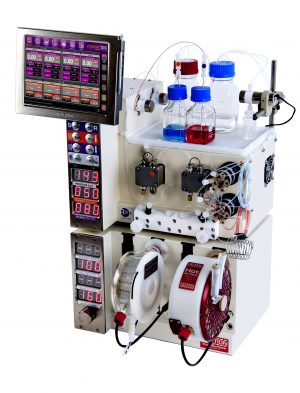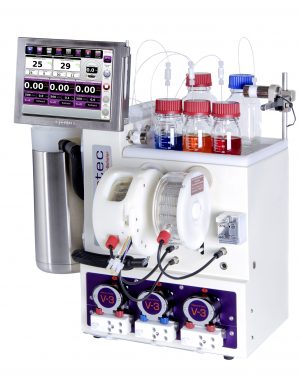Efficient Amino Donor Recycling in Amination Reactions: Development of a New Alanine Dehydrogenase in Continuous Flow and Dialysis Membrane Reactors
- David Roura Padrosa1
- Zoya Nisar2
- Francesca Paradisi1,2
- 1Department of Chemistry and Biochemistry, University of Bern, Freiestrasse 3, 3012 Bern, Switzerland
- 2School of Chemistry, University of Nottingham, University Park, Nottingham NG7 2RD, UK
 Read the publication that featured this abstract
Read the publication that featured this abstractTransaminases have arisen as one of the main biocatalysts for amine production but despite their many advantages, their stability is still a concern for widespread application. One of the reasons for their instability is the need to use an excess of the amino donor when trying to synthesise amines with unfavourable equilibria. To circumvent this, recycling systems for the amino donor, such as amino acid dehydrogenases or aldolases, have proved useful to push the equilibria while avoiding high amino donor concentrations. In this work, we report the use of a new alanine dehydrogenase from the halotolerant bacteria Halomonas elongata which exhibits excellent stability to different cosolvents, combined with the well characterised CbFDH as a recycling system of L-alanine for the amination of three model substrates with unfavourable equilibria. In a step forward, the amino donor recycling system has been co-immobilised and used in flow with success as well as re-used as a dialysis enclosed system for the amination of an aromatic aldehyde.
Get in touch
For more information on flow chemistry systems and services please use the contact methods below.
Call us on +44 (0)1284 728659 or Email us
Resource Centre
R-Series

The Vapourtec R-Series is, quite simply, unrivalled for flow chemistry
- Flexible |
- Precise |
- Automatable
The R-Series is undoubtedly the most versatile, modular flow chemistry system available today.
E-Series

The Vapourtec E-Series is the perfect introductory system for flow chemistry
- Robust |
- Easy to use |
- Affordable
The E-Series is a robust and affordable, entry level flow chemistry system designed for reliability and ease of use.
